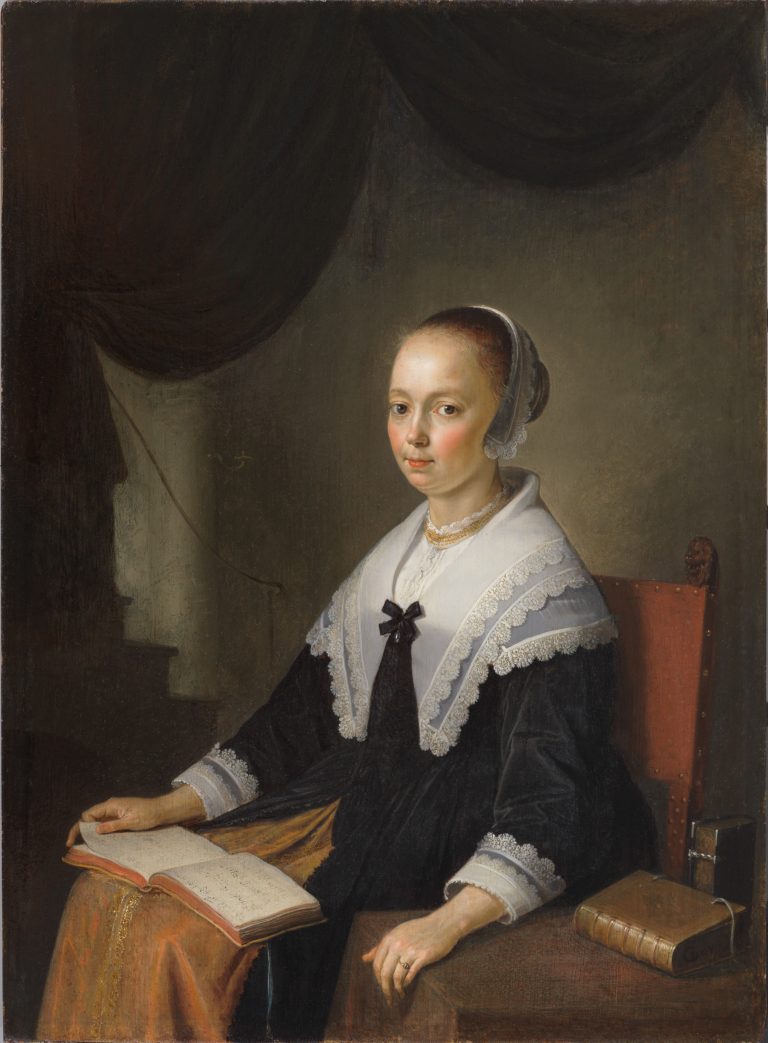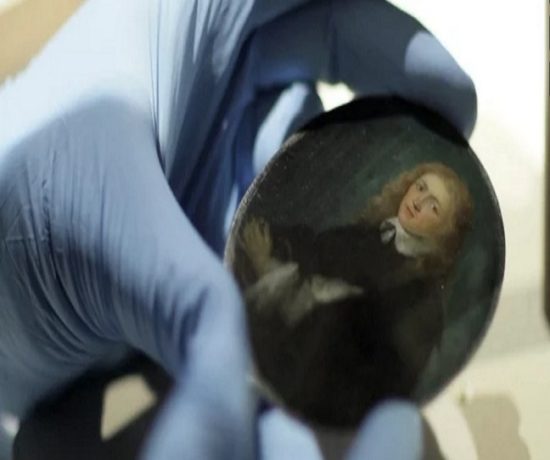Gerrit Dou’s small-scale portrait of this well-to-do young lady conveys much about her interests, values, and social class. Her tasteful jewelry and dress, as well as the open music book in her lap, suggest that she comes from a wealthy family from among Leiden’s literate circles. Her elegant attire consists of a three-tiered white linen neckerchief around her shoulders, with lace trim and matching lace cuffs that adorn her bracelet-length sleeves. She wears a high-necked white collar with several thin strands of gold beading, and an ornamental black stomacher accented with a bow from which hangs a single black pearl. This fashionable ensemble was current during the early 1640s and was also worn by ladies in Haarlem and Amsterdam, as seen, for example, in Frans Hals’s (1582/83–1666) Portrait of a Woman with a Fan of ca. 1640 in the National Gallery, London, and Rembrandt van Rijn’s (1606–69) Portrait of Agatha Bas from 1642 in the British Royal Collection (fig 1).1 Like Agatha Bas’s fashionable dress, the ensemble of the present sitter features an amber-colored satin skirt with gold embroidery that contrasts with her black outer gown. The scale of her lacework is much less bold and her accessories less ostentatious than that of her Haarlem and Amsterdam counterparts, indicating her more conservative taste. In keeping with her reserved demeanor, she wears her hair tied back in a traditional hairdo with a matching lace headdress that covers her ears and extends to the sides of her face.
Based on her dress style, Baer dates the present portrait to ca. 1640–44.2 Another closely related painting is Dou’s Portrait of a Lady (fig 2)3. In both of these works, Dou situated the woman in a simple interior space near a table with books and softened the scene with a deep reddish-brown curtain hanging above and to the left of the sitter. The present painting also includes a staircase and column at the left, which help to define the interior space of the room. The additional illumination from the left of this column also creates a play of light and shadow along the back wall, against which the lady is contrasted.
An X-radiograph indicates that the rectangular composition was initially conceived with an arched top. The greater visibility of the arch along the upper right-hand side coincides with the direction of the light that falls onto this area and accounts for the greater content of lead white in the underlying paint (fig 3). Pentimenti along the figure’s face, right arm, and shoulder seen in the X-radiograph, moreover, indicate that Dou initially positioned the sitter centrally beneath the painted arch and later shifted her to the right by about one centimeter, possibly when he modified the arched-top format and added the curtain to balance the composition. A similar combination is found in Dou’s Self-Portrait in a private collection in Spain, as well as in his Painter with a Pipe and Book in the Rijksmuseum, both from about 1645.4 The conventional format of the present portrait suggests that the sitter was married and that Dou most likely originally painted her portrait with a male pendant, placing the woman on the heraldic left. The ring on her left hand, which Dou executed with only a few strokes of paint, is probably a wedding ring.5
The books with which she is engaged suggest that she is a pious and educated individual. The ornamental clasp and gold detailing on the standing book on the table are characteristic of a Bible, while the open music book on her lap, which she actively thumbs as if to turn a page, indicates her proficiency in reading music. The musical notation of the book contains four staffs per page and is written with some beamed eighth and sixteenth notes, which would have been typical of a secular piece. The worn condition of the paint in this area, however, makes it impossible to determine whether the musical notation was once an identifiable song.
The paint surface is even and smooth, with visibly raised thicker paint throughout the elaborate detail work and highlights. These areas include the ornamental lace trim of the sitter’s collar, the golden brocade along the center of her skirt, and the sparse highlights applied to her headdress as well as to the bindings of the books on the table. Extremely fine brushstrokes, especially in the stray curly hairs framing the sitter’s face, indicate that the artist used a single, fine bristle for the application of the paint (fig 4). Though Dou’s polished handling of the brushwork in this portrait matches the refinement of the sitter, the treatment of her hair is reminiscent of the artist’s much looser handling of a peasant woman’s hair in the A Young Woman in Cleveland from about the same time (fig 5), a comparison that underscores the artist’s great versatility in brushwork depending on the formality of the subject matter.

